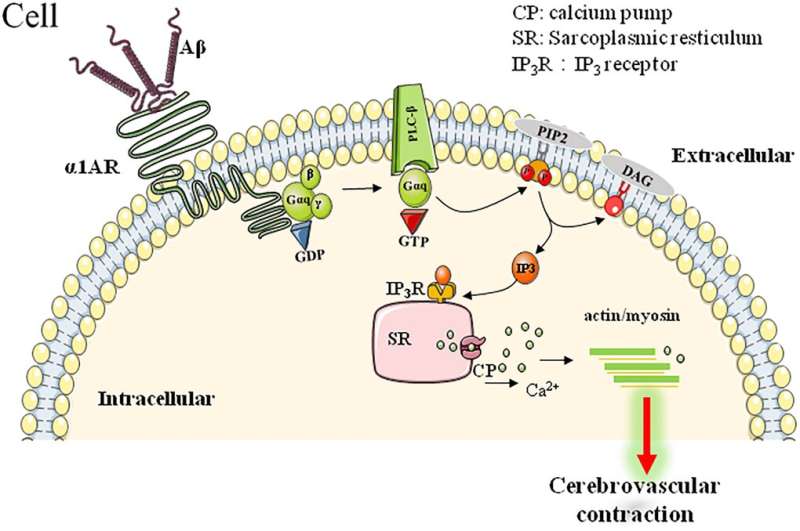Α1AR-mediated downstream signaling pathway involved in Aβ-induced cerebrovascular abnormalities. Credit: Song Li
Aging-US has published "Involvement of cerebrovascular abnormalities in the pathogenesis and progression of Alzheimer's disease: an adrenergic approach" which reported that alzheimer's disease, as the most common neurodegenerative disease in elder population, is pathologically characterized by β-amyloid plaques, neurofibrillary tangles composed of highly-phosphorylated tau protein and consequently progressive neurodegeneration.
Increasing lines of evidence from both clinical and preclinical studies have indicated that age-related cerebrovascular dysfunctions, including the changes in cerebrovascular microstructure, blood-brain barrier integrity, cerebrovascular reactivity and cerebral blood flow, accompany or even precede the development of AD-like pathologies.
In this review, the authors provide an appraisal of the cerebrovascular alterations in AD and the relationship to cognitive impairment and AD pathologies. Moreover, the adrenergic mechanisms leading to cerebrovascular and AD pathologies were further discussed.
Dr. Song Li and Dr. Jun Tan from Chinareport that "Alzheimer's disease (AD) is the most common form of neurodegenerative disease in elder population worldwide."
It is estimated that, by 2060, the number of AD patients in Americans age 65 and older may increase to 13.8 million from 6.2 million today. AD is clinically characterized as cognitive decline and psychiatric manifestations. AD is a progressive neurodegenerative disorder that can start decades before the appearance of clinical symptoms. Although several pathological mechanisms of AD have been identified, the authors believe that no satisfactorily effective therapeutics has been developed. Recently, cerebrovascular dysfunctions, as a possible cause in the development and progression of sporadic AD, have gained increasing attention.
Recent findings further highlighted the prevalence of cerebrovascular disorders in Down syndrome patients and added to a growing body of evidence implicating cerebrovascular abnormalities as a core feature of AD rather than a simple comorbidity.
Moreover, adrenergic system, including /β adrenergic receptors and their downstream molecular signaling process, might serve as the key approach to modulate these cerebrovascular abnormalities and progressive neurodegeneration.
The Li/Tan Research Team concluded that increasing lines of evidence from either preclinical or clinical studies have revealed that the cerebral vascular alterations during early stages of AD may contribute to the pathogenesis and progression of the disease. Cerebral vascular assessment may provide promising tools for AD early diagnosis and cerebral vascular remodeling may yield benefits to AD therapy.
More information: Song Li et al, Involvement of cerebrovascular abnormalities in the pathogenesis and progression of Alzheimer's disease: an adrenergic approach, Aging (2021). DOI: 10.18632/aging.203482
Provided by Impact Journals LLC
























